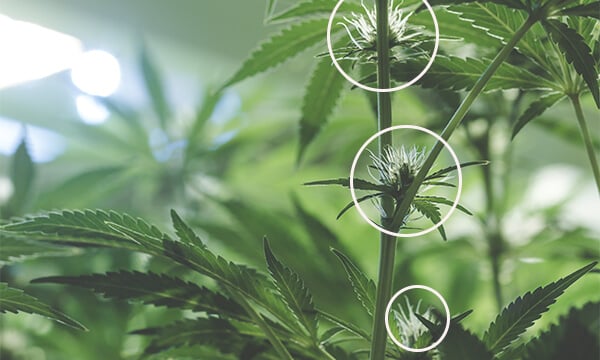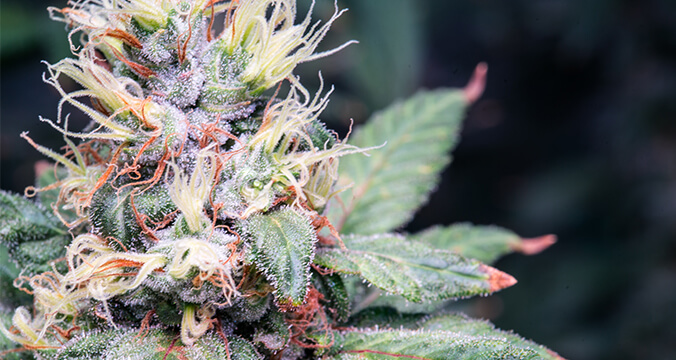Everything You Need To Know About Pistils On Cannabis
Published :
Jan 23, 2019
Categories :
Cannabis cultivation

If you have noticed several long, hair-like growths on your cannabis plant, then you are looking at pistils. A highly important part of cannabis anatomy, correctly identifying pistils is a must-have skill for any grower. If not, you could end up missing out on those all-important buds. Keep reading to find out more.
CANNABIS ANATOMY RECAP
To appreciate the importance of pistils, we first need to do a quick bit of cannabis growing 101. In recapping the core principles of marijuana growing, and the different parts of male and female plant anatomy, the purpose of pistils is easier to understand.
Cannabis plants can be three different sexes: male, female, and intersex (hermaphrodite). Most of the time, growers will want only female cannabis plants as these are the ones that produce smokable buds. If you are growing cannabis with the goal to produce seeds, however, then you will need both a female and male plant in order for the female to be pollinated. Moreover, from this anonymous sample of new seeds, there is no way to definitively determine the sex of each specimen until the plants reach the pre-flowering phase midway through veg.
WHAT IS A PISTIL?
Male plants don’t produce flowers; instead, they develop pollen sacks that, when mature, burst, spreading their pollen to female plants and fertilising them. For this to happen, the pollen has to come into contact with pistils. Also referred to as “stigmas”, they protrude from the calyx of a female plant.
The calyx has two functions depending on the circumstances. If a feminized plant is left to its own devices, the calyx will begin flowering and put its energy into developing buds. If, on the other hand, the pistil comes into contact with pollen, then the calyx becomes the ovary and will put its energy into producing seeds, not buds. The objective for most cultivators will be to produce seedless feminized cannabis plants, or “sensimilla”. These are the cannabis plants that provide us with large, resinous buds.

WHY ARE PISTILS IMPORTANT?
The importance of pistils is two-fold. First, they help us identify the sex of our cannabis plants, and second, they can be used to indicate when we should harvest during the flowering stage.
• Sexing Plants Via The Pistils
If we begin with the sexing of a cannabis plant, the technique is relatively simple. If pistils are present post-germination, then you have a female plant. If they are not, then the plant is male and should be removed immediately to prevent other plants being pollinated.
If we split cannabis plants into autoflowering and photoperiod categories, the former is the easiest to sex because flowering is rapid, and multiple pistils tend to appear at once. The latter can prove slightly more complex. Not because the pistils are necessarily tricky to spot, but because they can appear at different times depending on the genetics of the strain.
Typically, after 3–6 weeks into the vegetative cycle, the first few pistils should appear, at random, among nodes on the stem. However, in some strains, their appearance can be delayed, not showing until at least eight weeks. Keep a careful eye on plants during these weeks, and as soon as you spot those first initial pistils, you can breathe a sigh of relief—it’s a girl!
• Harvesting Plants Using The Pistil Method
We already have a comprehensive guide on how to use pistils to determine when to harvest cannabis; but in summary, the white pistils will begin to change colour during the flowering phase. Once the majority of pistils have started to turn orange, brown, and red, then you are ready to cut down those prized buds.
Given that the naked eye can see pistils, they are easier to observe than trichomes when it comes to harvesting. Having said that, using a pocket scope to monitor trichomes will give you a far more accurate timeframe for harvesting.

A SLIGHT COMPLICATION WITH PISTILS
A significant watch-out for growers is that plants can become intersex if subjected to intense stress during either the vegetative or flowering stages. This can happen regardless of the starting sex of a plant; so if you successfully identify female plants, that doesn't mean you can throw caution to the wind.
An intersex plant will have both male and female reproductive organs. This means pistils will still exist, but the plant possesses the ability to self-pollinate. Be careful during veg and bloom to maintain optimal conditions. Especially during flowering, photoperiod plants are extremely vulnerable to any light leaks in the dark cycle. Whether it’s from grow lights or street lights, light leaks are known to cause plants to turn intersex. Removing or reducing any factors that might cause stress should prevent an intersex plant from developing.
WHEN ARE PISTILS NOT A GOOD SIGN?
So far, the presence of pistils can be used to identify a plant’s sex and to help with harvest timescales; that doesn't, however, mean the presence of pistils is always a good sign.
Heat and lighting are two primary factors that can cause pistils to continue developing, even if a plant is late into the flowering stage. If pistils continue to build on parts of the bud closest to your light source, then you may have a problem. You should use the original buds, pistils, and trichomes as a sign your plants are ready to harvest, rather than relying on the new growth. They will look immature, regardless of whether your cannabis is at its peak, because of how late into the flowering cycle they began to develop.
To prevent this from happening, a consistent temperature is needed. If cannabis plants are getting warmer temperatures at the top of the canopy than the bottom, the stress can prompt new growth. The same principle applies to light, so ensure coverage is spread evenly to prevent buds from foxtailing. Buds that have developed because of stress can still be harvested and smoked in the same way as the rest of the plant. They are, however, a clear sign that your cannabis is experiencing abnormal conditions, and as a grower, you need to take some form of remedial action.
FINAL THOUGHTS
A final observation when it comes to pistils is that it is not uncommon for new sets of pistils to appear during the flowering stage, even if conditions are optimal. This is a genetic feature that some strains posses. Usually more prevalent in sativas, it can be counteracted by increasing dark time and tricking plants into thinking winter is coming. Reducing light exposure to 11/13 or 10/14 should speed up flowering and support a plant’s readiness to be harvested.
All in all, pistils are a fascinating part of the cannabis anatomy. Their use as a means of sexing plants, and deciphering the correct time to harvest, make them an invaluable tool in the cannabis grower’s arsenal.






































